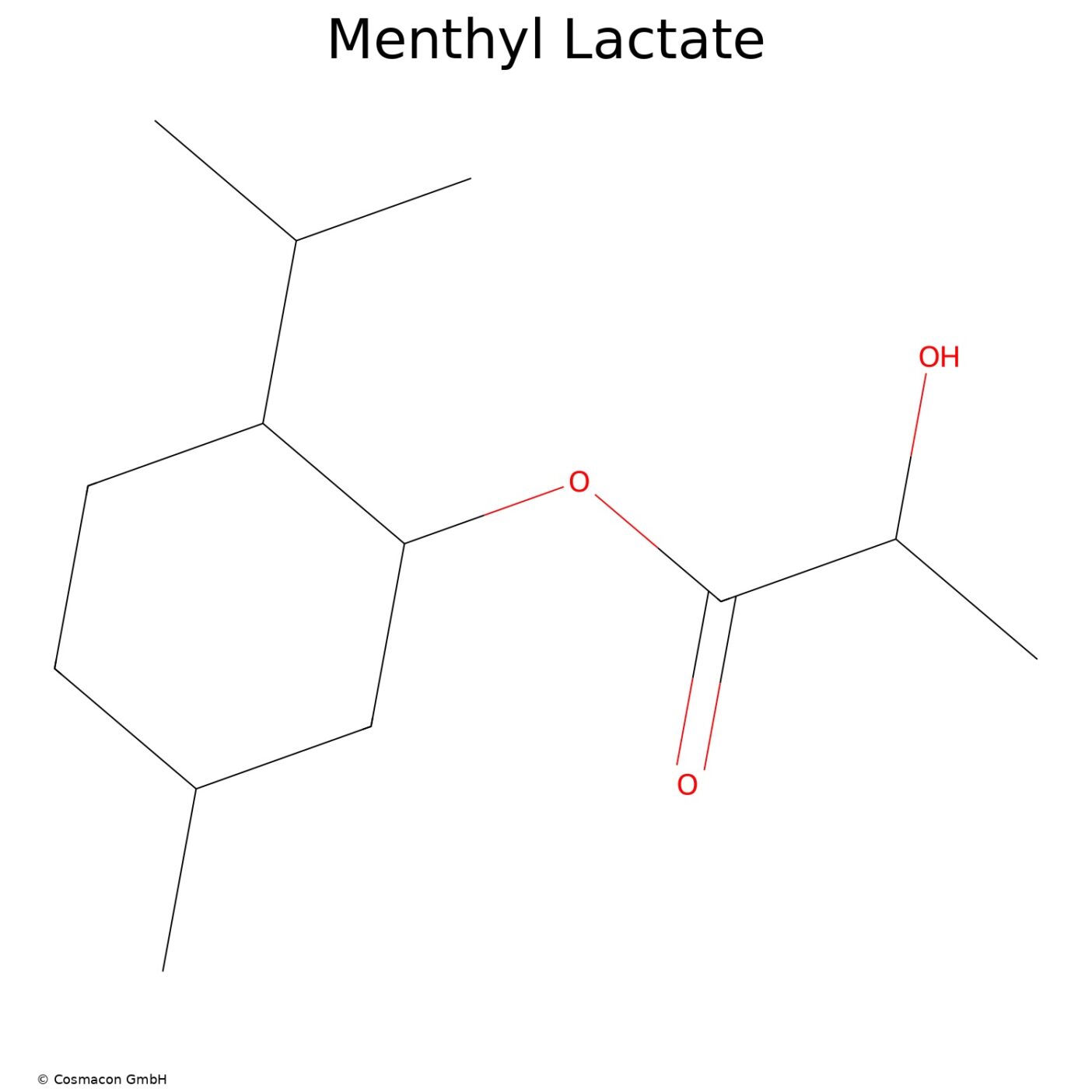Mentyl lactate

Mentyl lactate is a fascinating fragrance and ingredient for skin care that is increasingly being used in the cosmetics world. In this blog article, we explain clearly what mentyl lactate is, how it occurs in nature, how it is obtained, what its advantages and disadvantages are, and where it is used in cosmetic products. Finally, we provide a clear fact sheet. We conclude by showing how Cosmacon GmbH can use menthyl lactate to develop effective cosmetic products and strengthen its brand.
Occurrence in nature
Menthyl lactate occurs naturally in various plants of the mint family (Lamiaceae). It is an ester formed from menthol and lactic acid. Typical plants with natural menthyl lactate content include peppermint (Mentha × piperita) and spearmint (Mentha spicata). The botanical names are:
Mentha × piperita (peppermint)
Mentha spicata (spearmint).
These plants prefer to grow in the temperate climates of Europe, North America and Asia. They reach a height of about 30–90 cm and typically flower in midsummer. They are usually harvested in late July to August, when the essential oils are particularly concentrated. The growing conditions include moist, loose soils with good sunlight. Under ideal conditions, these plants can live for several years, as peppermint is perennial and can grow for several consecutive growing seasons.
Extraction (production methods)
There are two main methods of extraction for menthyl lactate:
– Distillation: The plant parts (leaves and flowers) are steam distilled to extract the essential oils. The menthyl lactate is isolated from these oils through further purification and chemical conversion.
– Synthetic production: Menthyl lactate can also be obtained industrially through the chemical esterification of menthol with lactic acid. This method allows for high purity and consistent quality.
Advantages and disadvantages of menthyl lactate
Advantages of menthyl lactate:
– Mild cooling effect: similar to menthol, but significantly gentler.
– Pleasant, fresh scent, ideal for refreshing and after-sun products.
– Good skin compatibility, even for sensitive skin types.
– Flexible use in formulations of lotions, creams, shampoos or foot care products.
Disadvantages of menthyl lactate:
– Cost: Natural extraction can be more complex and expensive. However, synthetic production can be cost-effective.
– Perfume allergies: As with many fragrances, isolated cases of sensitivity may occur, which can lead to skin reactions in sensitive skin.
– Stability: In some formulations, chemical stability must be carefully checked, especially in products with fluctuating pH levels.
Use in cosmetic products
Mentyl lactate is used in numerous cosmetic products.
– After-sun lotions: – Provides a refreshing cooling effect without menthol strength.
– Foot care: Has a cooling and deodorising effect.
– Deodorants/sprays: – Fresh scent and gentle cooling.
– Shampoos and shower gels: Invigorating, ideal for a refreshing shower.
– Creams and gels: Particularly valued in summer moisturising gels.
Other daily applications with mentyl lactate
In addition to cosmetics, menthyl lactate is used in:
– Room fragrances: For a gentle, fresh aroma in indoor spaces.
– Wellness products: – Massage oils or bath additives to provide cooling freshness.
– Headache products: The gentle cooling effect promotes a feeling of well-being.
Chemical and physical data of menthyl lactate
Menthyl lactate is usually a colourless to slightly yellowish liquid. It is in a liquid state and has a melting point below room temperature, which means that it remains liquid even at normal ambient temperatures. Its molecular formula is C₁₁H₂₀O₂, classifying it as an organic compound consisting of carbon, hydrogen and oxygen.
In terms of solubility, menthyl lactate is highly soluble in lipophilic substances (i.e. fats and oils) and shows moderate solubility in ethanol. This makes it particularly useful for oil- or alcohol-based cosmetic formulations.
The official INCI name for menthyl lactate is “Menthyl Lactate”. It is also known under the alternative names menthol lactate or menthyl lactate.
These properties make menthyl lactate a versatile and valued ingredient in cosmetic development, especially in products that are intended to have a cooling effect but without the intense side effects of pure menthol.
Here is a brief look at menthol, the substance on which menthyl lactate is based:
Appearance: crystalline, colourless to white solid.
Physical state: solid
Melting point: approx. 42–43 °C
Solubility: slightly soluble in water, highly soluble in ethanol and oil
INCI name: menthol
Efficacy tests show that menthol produces a strong cooling effect by binding to cold receptors in the skin (TRPM8).
Studies confirm a significant subjective cooling effect and reduced skin temperature.
Conclusion Mentyl lactate
Mentyl lactate is a versatile, mildly cooling ingredient with a pleasant fragrance and good skin compatibility – ideal for modern, refreshing cosmetic products. It meets consumer demands for gentle, long-lasting freshness without the intensity of menthol.
The cooling ingredient menthyl lactate offers the following opportunities:
– Development of innovative after-sun, foot care or freshness products with unique selling points.
Position your brand as skin-friendly and modern thanks to this gentle, effective ingredient.
It can also be combined with natural or mild components to communicate high-quality, sustainable brand messages (e.g. aloe reinforcement, moisturising esters).
With menthyl lactate, we can develop products for you that not only offer a fresh fragrance and pleasant cooling sensation, but also feel noticeably good on the skin – strengthening your brand identity and inspiring your customers in the long term.
Literature:
1. Case study on the safety of L-menthyl D-lactate
A recent case study investigates the systemic safety of L-menthyl D-lactate compared to related substances such as DL-menthol and D-lactic acid.
ACS Publications+11Ataman Chemicals+11SpecialChem+11ScienceDirect+2Fragrance Material Safety Resource+2
2. Patent: ‘Cosmetic composition based on menthol and menthyl lactate’ (US20020119110A1)
Describes a refreshing, non-irritating cosmetic formulation with menthol and menthyl lactate (0.1–10% by weight), optimally in a ratio of approximately 1:5.
3. Patent: ‘Menthyl lactate process’ (US7173146B1)
Presents an efficient process for producing menthyl lactate by esterification of menthol with lactic acid, followed by targeted hydrolysis to maximise yield (97–98% purity).